light TOYOTA C-HR 2020 Warranties & Maintenance Guides (in English)
[x] Cancel search | Manufacturer: TOYOTA, Model Year: 2020, Model line: C-HR, Model: TOYOTA C-HR 2020Pages: 260, PDF Size: 8.54 MB
Page 4 of 260
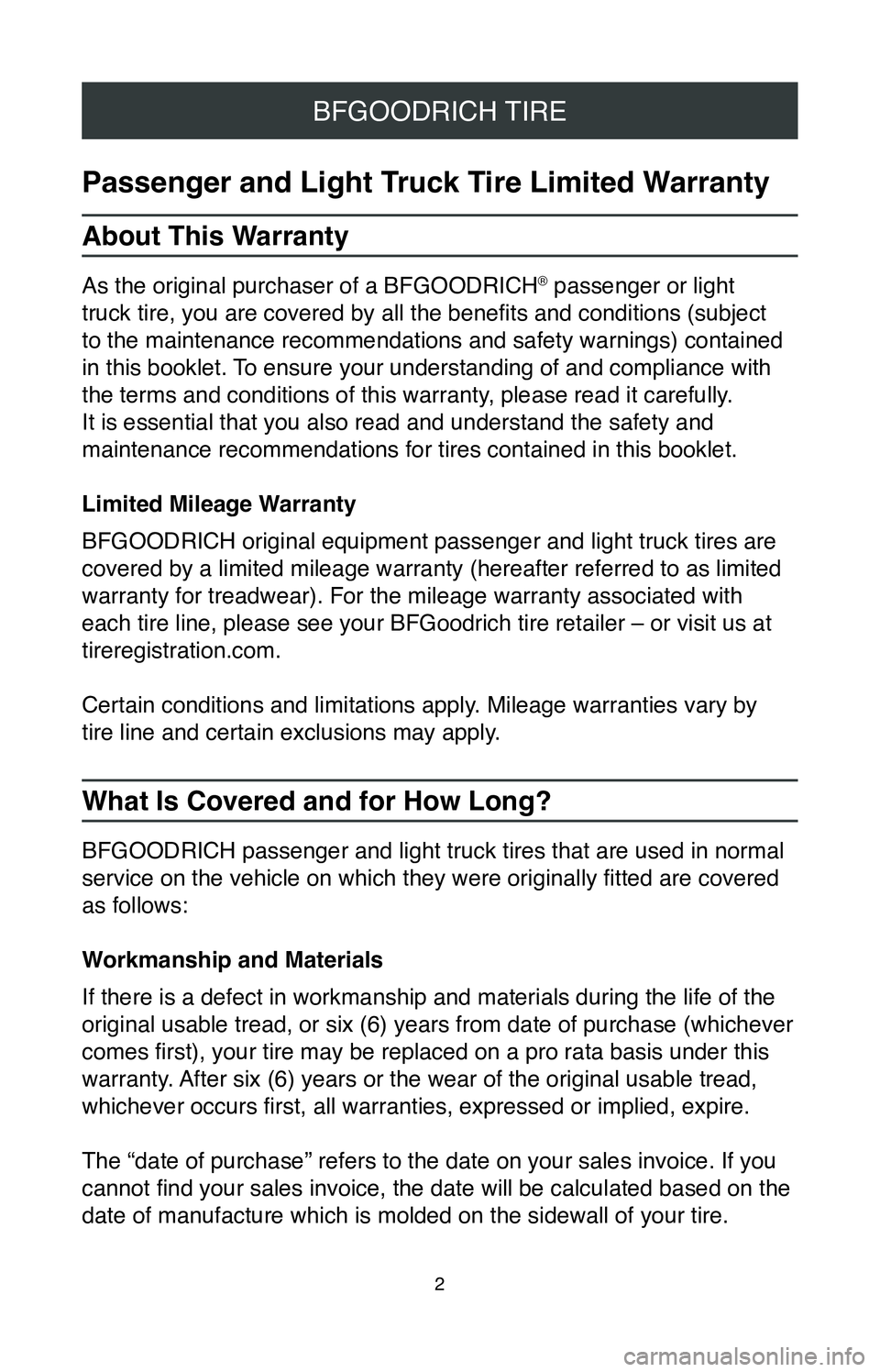
2
BFGOODRICH TIRE
Passenger and Light Truck Tire Limited Warranty
About This Warranty
As the original purchaser of a BFGOODRICH® passenger or light
truck tire, you are covered by all the benefits and conditions (subject
to the maintenance recommendations and safety warnings) contained
in this booklet. To ensure your understanding of and compliance with
the terms and conditions of this warranty, please read it carefully.
It is essential that you also read and understand the safety and
maintenance recommendations for tires contained in this booklet.
Limited Mileage Warranty
BFGOODRICH original equipment passenger and light truck tires are
covered by a limited mileage warranty (hereafter referred to as limited
warranty for treadwear). For the mileage warranty associated with
each tire line, please see your BFGoodrich tire retailer – or visit u\
s at
tireregistration.com.
Certain conditions and limitations apply. Mileage warranties vary by
tire line and certain exclusions may apply.
What Is Covered and for How Long?
BFGOODRICH passenger and light truck tires that are used in normal
service on the vehicle on which they were originally fitted are covered
as follows:
Workmanship and Materials
If there is a defect in workmanship and materials during the life of the\
original usable tread, or six (6) years from date of purchase (whichever
comes first), your tire may be replaced on a pro rata basis under this
warranty. After six (6) years or the wear of the original usable tread,
whichever occurs first, all warranties, expressed or implied, expire.
The “date of purchase” refers to the date on your sales invoice. I\
f you
cannot find your sales invoice, the date will be calculated based on the
date of manufacture which is molded on the sidewall of your tire.
Page 17 of 260
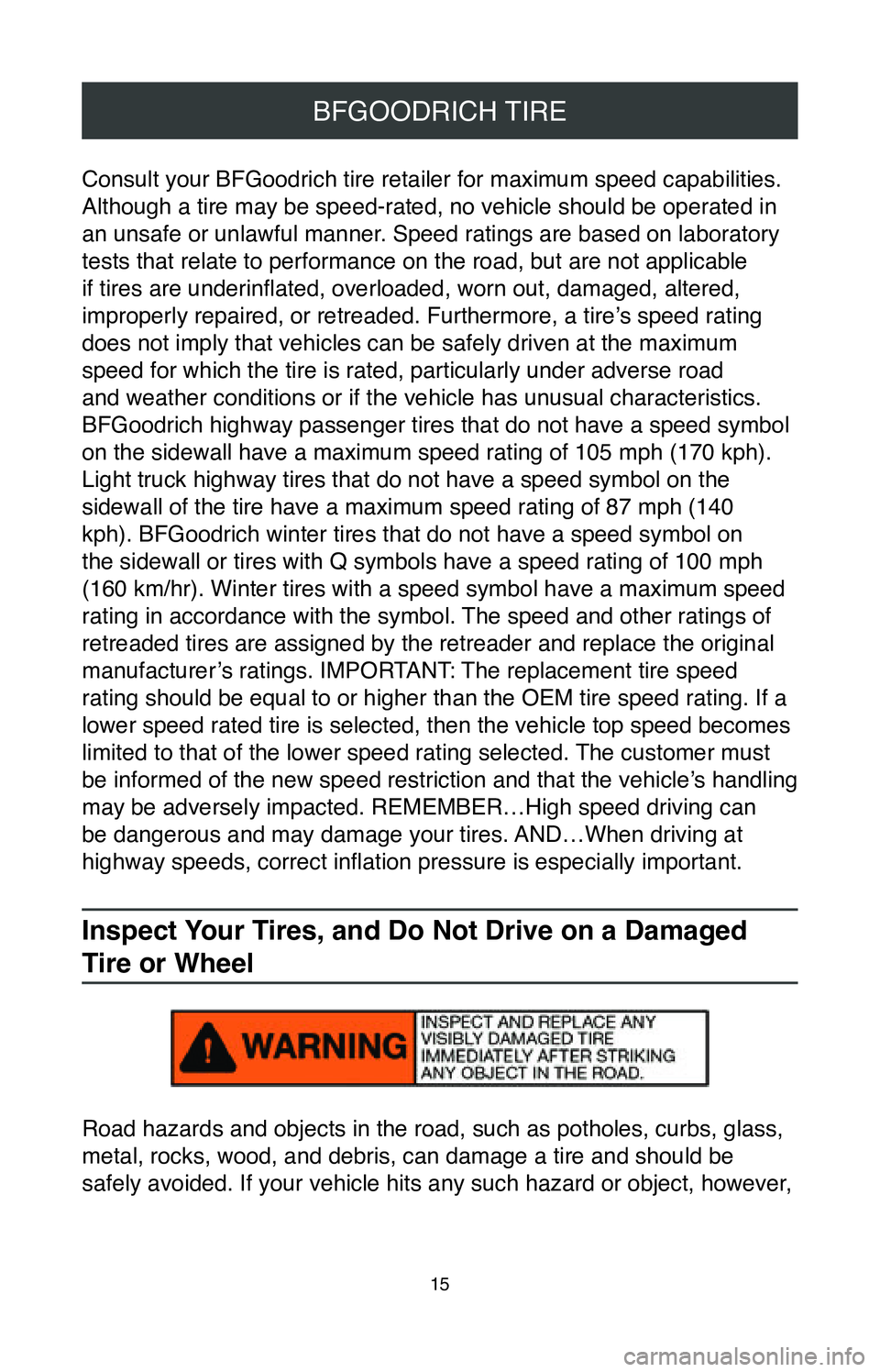
15
BFGOODRICH TIRE
Consult your BFGoodrich tire retailer for maximum speed capabilities.
Although a tire may be speed-rated, no vehicle should be operated in
an unsafe or unlawful manner. Speed ratings are based on laboratory
tests that relate to performance on the road, but are not applicable
if tires are underinflated, overloaded, worn out, damaged, altered,
improperly repaired, or retreaded. Furthermore, a tire’s speed rating
does not imply that vehicles can be safely driven at the maximum
speed for which the tire is rated, particularly under adverse road
and weather conditions or if the vehicle has unusual characteristics.
BFGoodrich highway passenger tires that do not have a speed symbol
on the sidewall have a maximum speed rating of 105 mph (170 kph).
Light truck highway tires that do not have a speed symbol on the
sidewall of the tire have a maximum speed rating of 87 mph (140
kph). BFGoodrich winter tires that do not have a speed symbol on
the sidewall or tires with Q symbols have a speed rating of 100 mph
(160 km/hr). Winter tires with a speed symbol have a maximum speed
rating in accordance with the symbol. The speed and other ratings of
retreaded tires are assigned by the retreader and replace the original
manufacturer’s ratings. IMPORTANT: The replacement tire speed
rating should be equal to or higher than the OEM tire speed rating. If a\
lower speed rated tire is selected, then the vehicle top speed becomes
limited to that of the lower speed rating selected. The customer must
be informed of the new speed restriction and that the vehicle’s handling
may be adversely impacted. REMEMBER…High speed driving can
be dangerous and may damage your tires. AND…When driving at
highway speeds, correct inflation pressure is especially important.
Inspect Your Tires, and Do Not Drive on a Damaged
Tire or Wheel
Road hazards and objects in the road, such as potholes, curbs, glass,
metal, rocks, wood, and debris, can damage a tire and should be
safely avoided. If your vehicle hits any such hazard or object, however,
Page 23 of 260
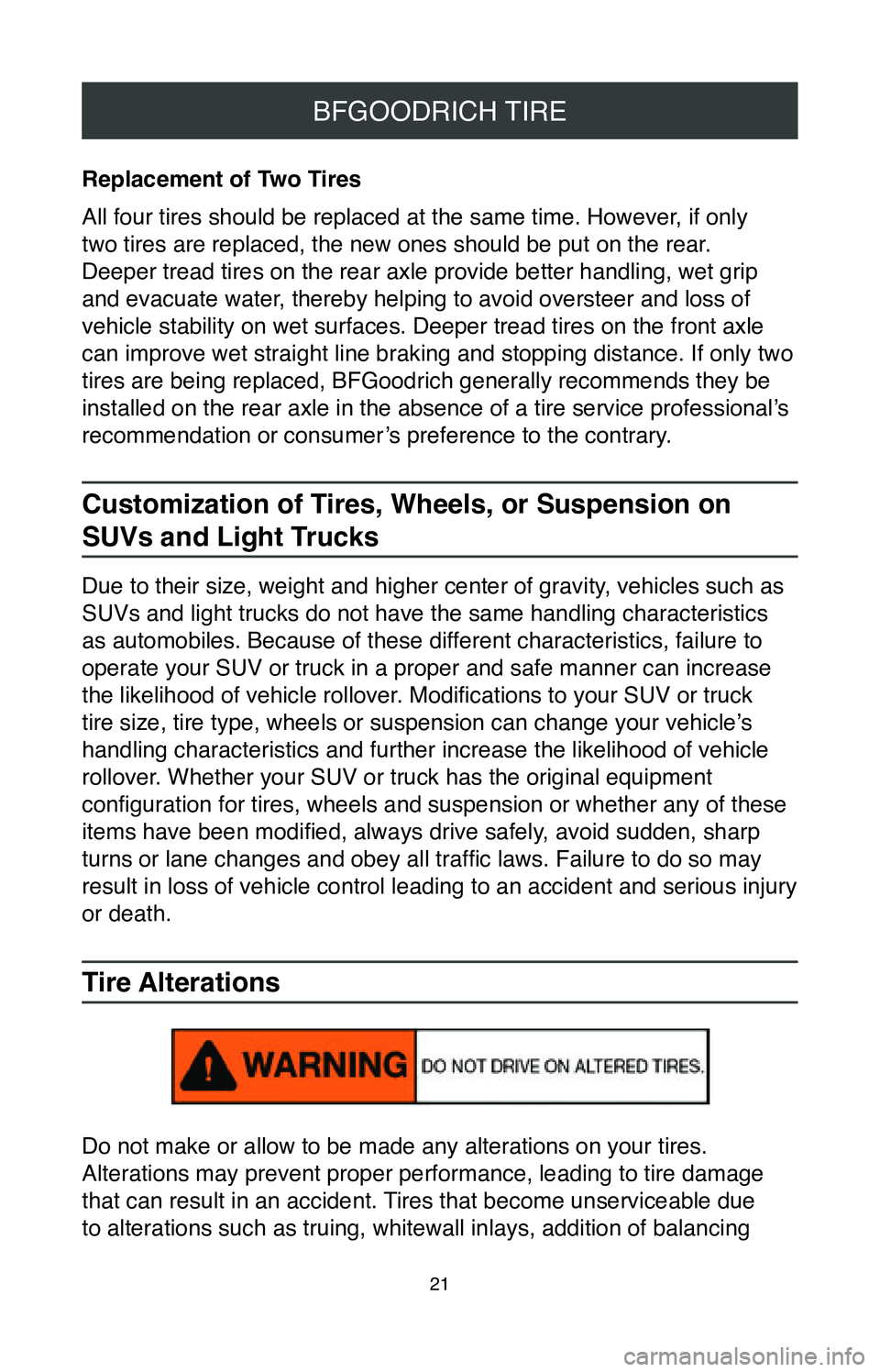
21
BFGOODRICH TIRE
Replacement of Two Tires
All four tires should be replaced at the same time. However, if only
two tires are replaced, the new ones should be put on the rear.
Deeper tread tires on the rear axle provide better handling, wet grip
and evacuate water, thereby helping to avoid oversteer and loss of
vehicle stability on wet surfaces. Deeper tread tires on the front axle \
can improve wet straight line braking and stopping distance. If only two\
tires are being replaced, BFGoodrich generally recommends they be
installed on the rear axle in the absence of a tire service professional’s
recommendation or consumer’s preference to the contrary.
Customization of Tires, Wheels, or Suspension on
SUVs and Light Trucks
Due to their size, weight and higher center of gravity, vehicles such as
SUVs and light trucks do not have the same handling characteristics
as automobiles. Because of these different characteristics, failure to
operate your SUV or truck in a proper and safe manner can increase
the likelihood of vehicle rollover. Modifications to your SUV or truck
tire size, tire type, wheels or suspension can change your vehicle’ s
handling characteristics and further increase the likelihood of vehicle \
rollover. Whether your SUV or truck has the original equipment
configuration for tires, wheels and suspension or whether any of these
items have been modified, always drive safely, avoid sudden, sharp
turns or lane changes and obey all traffic laws. Failure to do so may
result in loss of vehicle control leading to an accident and serious injury
or death.
Tire Alterations
Do not make or allow to be made any alterations on your tires.
Alterations may prevent proper performance, leading to tire damage
that can result in an accident. Tires that become unserviceable due
to alterations such as truing, whitewall inlays, addition of balancing
Page 24 of 260
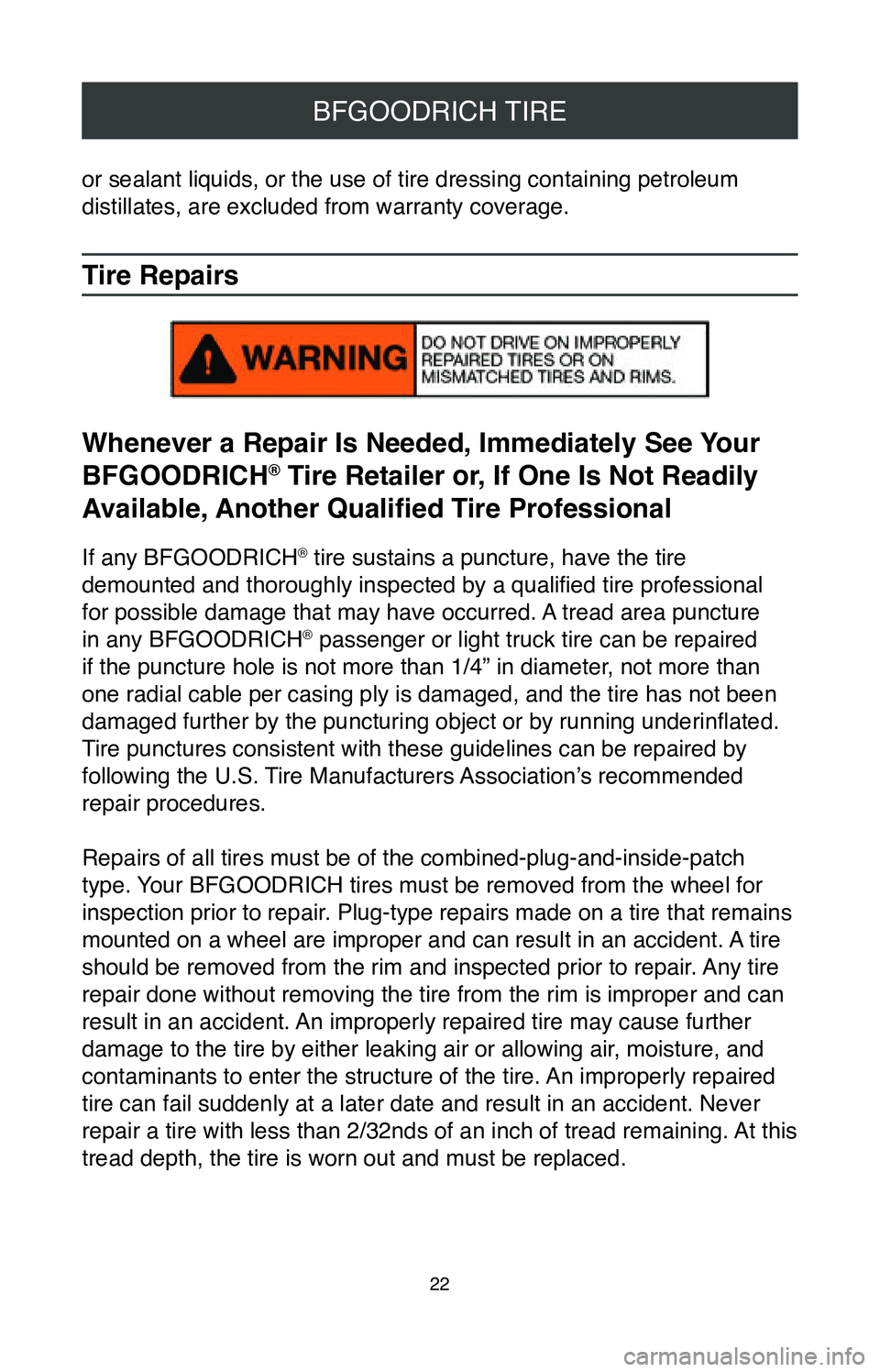
22
BFGOODRICH TIRE
or sealant liquids, or the use of tire dressing containing petroleum
distillates, are excluded from warranty coverage.
Tire Repairs
Whenever a Repair Is Needed, Immediately See Your
BFGOODRICH
® Tire Retailer or, If One Is Not Readily
Available, Another Qualified Tire Professional
If any BFGOODRICH® tire sustains a puncture, have the tire
demounted and thoroughly inspected by a qualified tire professional
for possible damage that may have occurred. A tread area puncture
in any BFGOODRICH
® passenger or light truck tire can be repaired
if the puncture hole is not more than 1/4” in diameter, not more than
one radial cable per casing ply is damaged, and the tire has not been
damaged further by the puncturing object or by running underinflated.
Tire punctures consistent with these guidelines can be repaired by
following the U.S. Tire Manufacturers Association’s recommended
repair procedures.
Repairs of all tires must be of the combined-plug-and-inside-patch
type. Your BFGOODRICH tires must be removed from the wheel for
inspection prior to repair. Plug-type repairs made on a tire that remains
mounted on a wheel are improper and can result in an accident. A tire
should be removed from the rim and inspected prior to repair. Any tire
repair done without removing the tire from the rim is improper and can
result in an accident. An improperly repaired tire may cause further
damage to the tire by either leaking air or allowing air, moisture, and
contaminants to enter the structure of the tire. An improperly repaired
tire can fail suddenly at a later date and result in an accident. Never \
repair a tire with less than 2/32nds of an inch of tread remaining. At this
tread depth, the tire is worn out and must be replaced.
Page 27 of 260
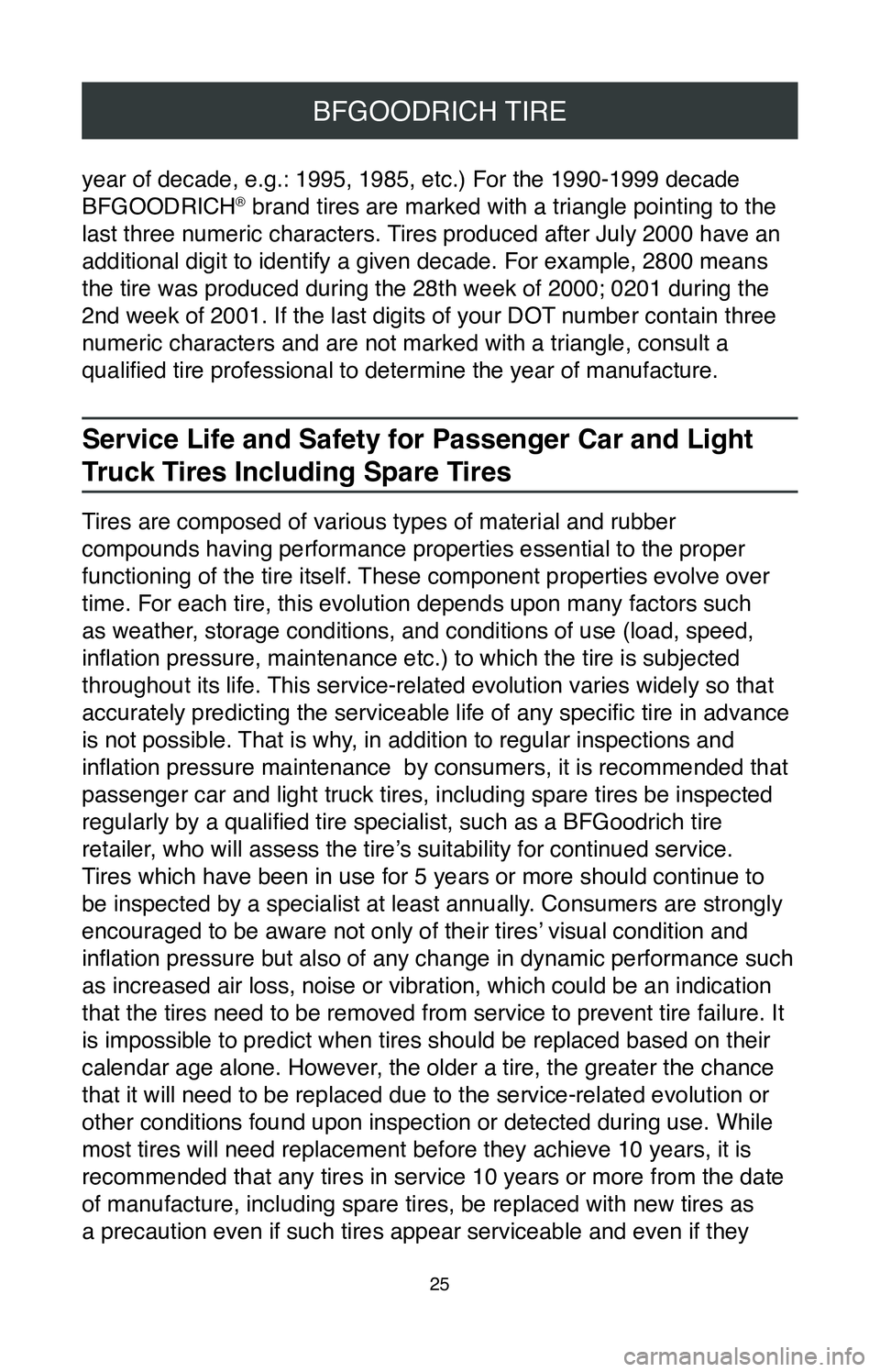
25
BFGOODRICH TIRE
year of decade, e.g.: 1995, 1985, etc.) For the 1990-1999 decade
BFGOODRICH® brand tires are marked with a triangle pointing to the
last three numeric characters. Tires produced after July 2000 have an
additional digit to identify a given decade. For example, 2800 means
the tire was produced during the 28th week of 2000; 0201 during the
2nd week of 2001. If the last digits of your DOT number contain three
numeric characters and are not marked with a triangle, consult a
qualified tire professional to determine the year of manufacture.
Service Life and Safety for Passenger Car and Light
Truck Tires Including Spare Tires
Tires are composed of various types of material and rubber
compounds having performance properties essential to the proper
functioning of the tire itself. These component properties evolve over
time. For each tire, this evolution depends upon many factors such
as weather, storage conditions, and conditions of use (load, speed,
inflation pressure, maintenance etc.) to which the tire is subjected
throughout its life. This service-related evolution varies widely so that
accurately predicting the serviceable life of any specific tire in advance
is not possible. That is why, in addition to regular inspections and
inflation pressure maintenance by consumers, it is recommended that
passenger car and light truck tires, including spare tires be inspected \
regularly by a qualified tire specialist, such as a BFGoodrich tire
retailer, who will assess the tire’s suitability for continued service.
Tires which have been in use for 5 years or more should continue to
be inspected by a specialist at least annually. Consumers are strongly
encouraged to be aware not only of their tires’ visual condition and
inflation pressure but also of any change in dynamic performance such
as increased air loss, noise or vibration, which could be an indication \
that the tires need to be removed from service to prevent tire failure. \
It
is impossible to predict when tires should be replaced based on their
calendar age alone. However, the older a tire, the greater the chance
that it will need to be replaced due to the service-related evolution or
other conditions found upon inspection or detected during use. While
most tires will need replacement before they achieve 10 years, it is
recommended that any tires in service 10 years or more from the date
of manufacture, including spare tires, be replaced with new tires as
a precaution even if such tires appear serviceable and even if they
Page 30 of 260
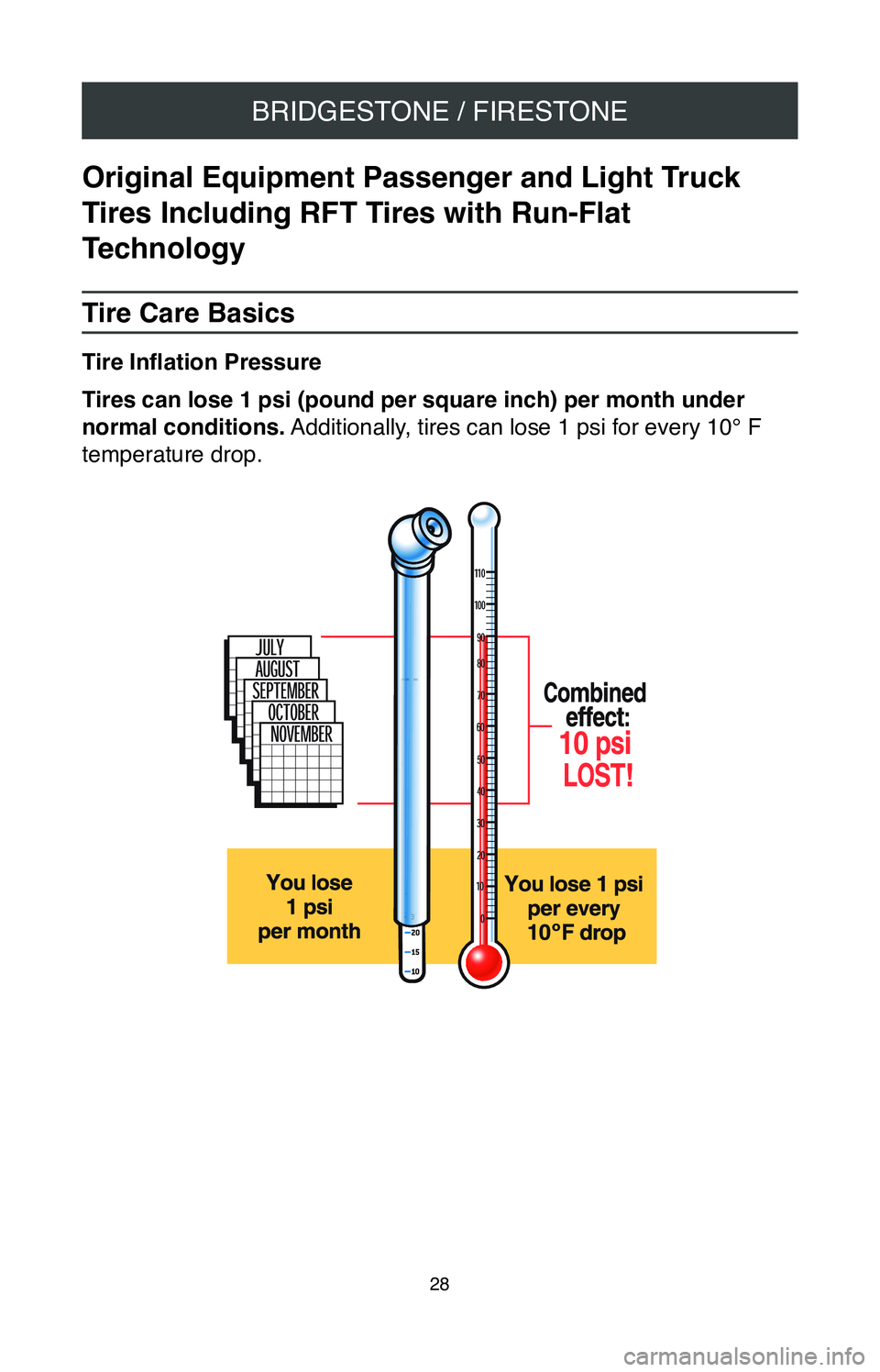
BRIDGESTONE / FIRESTONE
28
Original Equipment Passenger and Light Truck
Tires Including RFT Tires with Run-Flat
Technology
Tire Care Basics
Tire Inflation Pressure
Tires can lose 1 psi (pound per square inch) per month under
normal conditions. Additionally, tires can lose 1 psi for every 10° F
temperature drop.
Page 45 of 260
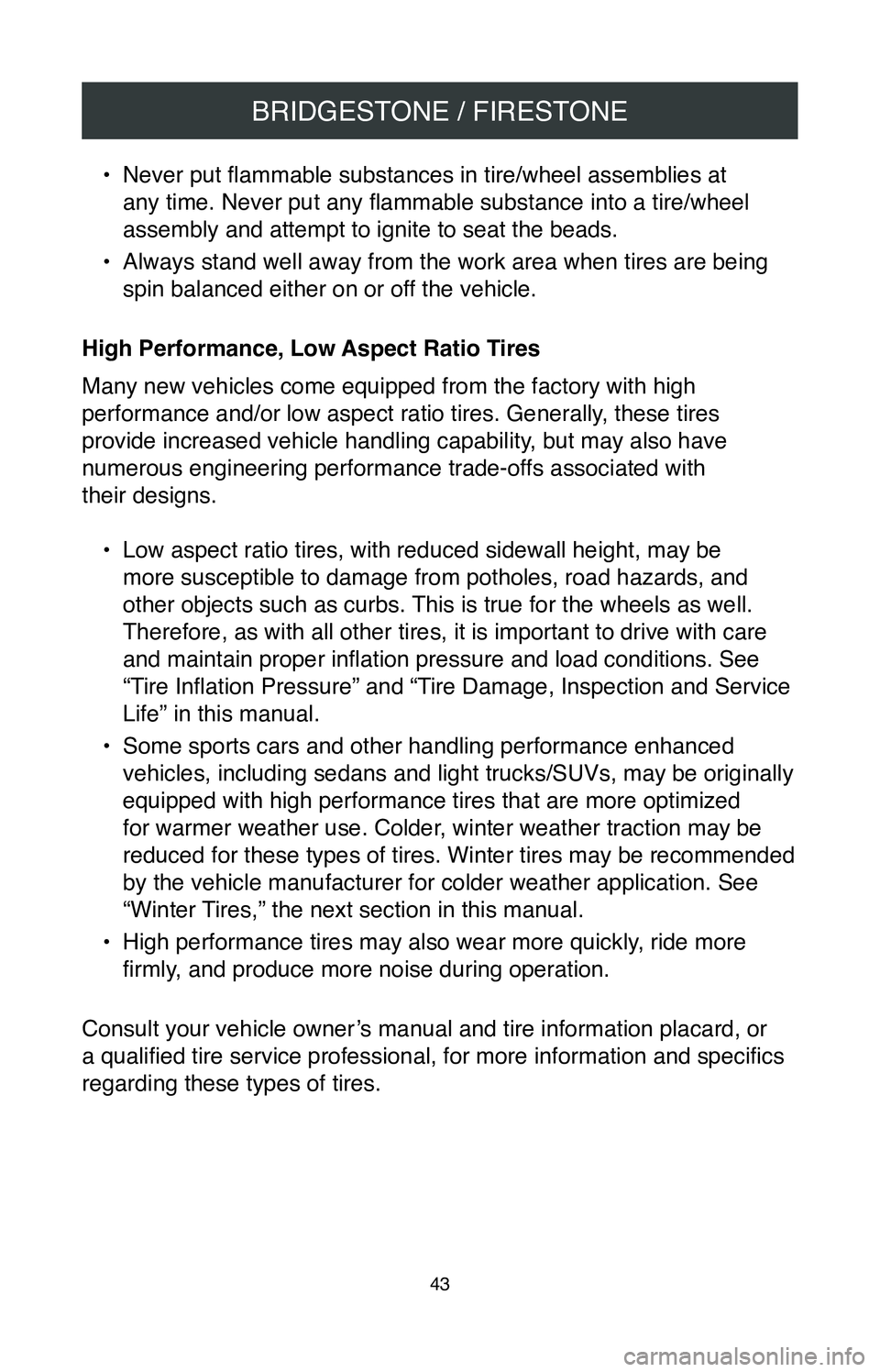
BRIDGESTONE / FIRESTONE
43
• Never put flammable substances in tire/wheel assemblies at
any time. Never put any flammable substance into a tire/wheel
assembly and attempt to ignite to seat the beads.
•
Always stand well away from the work area when tires are being
spin balanced either on or off the vehicle.
High Performance, Low Aspect Ratio Tires
Many new vehicles come equipped from the factory with high
performance and/or low aspect ratio tires. Generally, these tires
provide increased vehicle handling capability, but may also have
numerous engineering performance trade-offs associated with
their designs. •
Low aspect ratio tires, with reduced sidewall height, may be
more susceptible to damage from potholes, road hazards, and
other objects such as curbs. This is true for the wheels as well.
Therefore, as with all other tires, it is important to drive with care
and maintain proper inflation pressure and load conditions. See
“Tire Inflation Pressure” and “Tire Damage, Inspection and Service
Life” in this manual.
•
Some sports cars and other handling performance enhanced
vehicles, including sedans and light trucks/SUVs, may be originally
equipped with high performance tires that are more optimized
for warmer weather use. Colder, winter weather traction may be
reduced for these types of tires. Winter tires may be recommended
by the vehicle manufacturer for colder weather application. See
“Winter Tires,” the next section in this manual.
•
High performance tires may also wear more quickly, ride more
firmly, and produce more noise during operation.
Consult your vehicle owner’s manual and tire information placard, or
a qualified tire service professional, for more information and specifics
regarding these types of tires.
Page 46 of 260
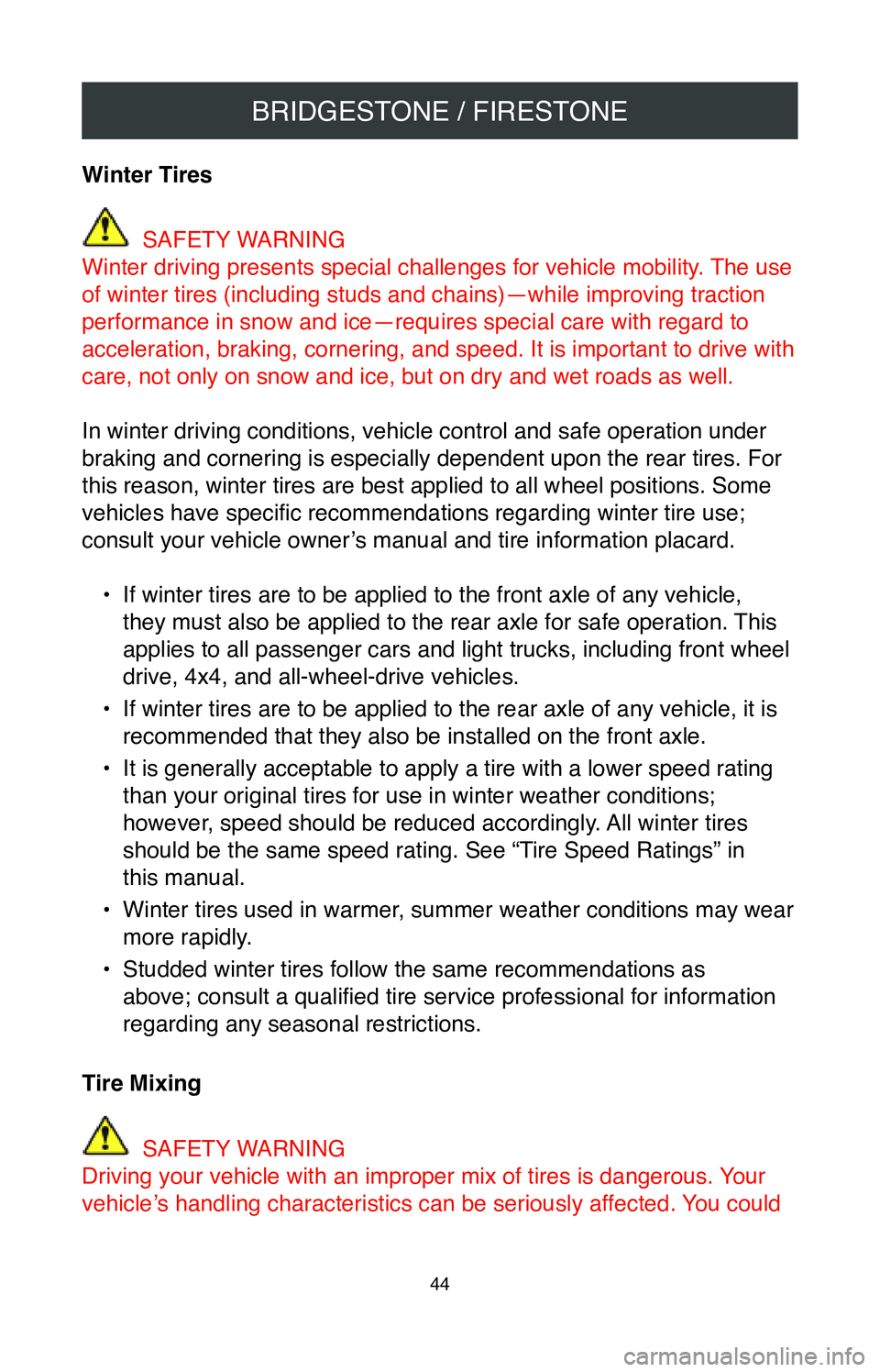
BRIDGESTONE / FIRESTONE
44
Winter Tires
SAFETY WARNING
Winter driving presents special challenges for vehicle mobility. The use
of winter tires (including studs and chains)—while improving traction
performance in snow and ice—requires special care with regard to
acceleration, braking, cornering, and speed. It is important to drive wi\
th
care, not only on snow and ice, but on dry and wet roads as well.
In winter driving conditions, vehicle control and safe operation under
braking and cornering is especially dependent upon the rear tires. For
this reason, winter tires are best applied to all wheel positions. Some \
vehicles have specific recommendations regarding winter tire use;
consult your vehicle owner’s manual and tire information placard.
•
If winter tires are to be applied to the front axle of any vehicle,
they must also be applied to the rear axle for safe operation. This
applies to all passenger cars and light trucks, including front wheel
drive, 4x4, and all-wheel-drive vehicles.
•
If winter tires are to be applied to the rear axle of any vehicle, it is\
recommended that they also be installed on the front axle.
•
It is generally acceptable to apply a tire with a lower speed rating
than your original tires for use in winter weather conditions;
however, speed should be reduced accordingly. All winter tires
should be the same speed rating. See “Tire Speed Ratings” in
this manual.
•
Winter tires used in warmer, summer weather conditions may wear
more rapidly.
•
Studded winter tires follow the same recommendations as
above; consult a qualified tire service professional for information
regarding any seasonal restrictions.
Tire Mixing
SAFETY WARNING
Driving your vehicle with an improper mix of tires is dangerous. Your
vehicle’s handling characteristics can be seriously affected. You could
Page 48 of 260
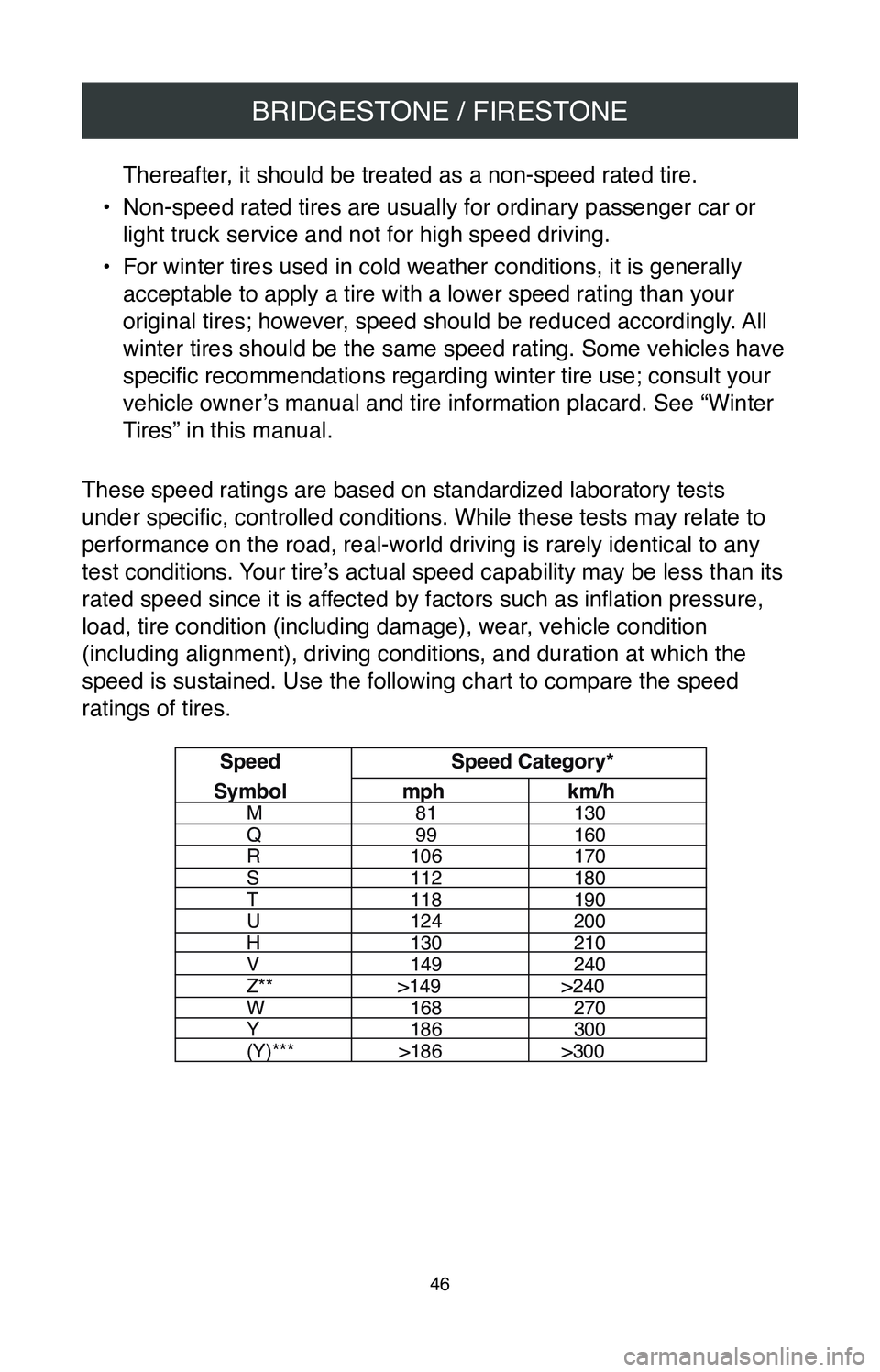
BRIDGESTONE / FIRESTONE
46
Thereafter, it should be treated as a non-speed rated tire.
•
Non-speed rated tires are usually for ordinary passenger car or
light truck service and not for high speed driving.
•
For winter tires used in cold weather conditions, it is generally
acceptable to apply a tire with a lower speed rating than your
original tires; however, speed should be reduced accordingly. All
winter tires should be the same speed rating. Some vehicles have
specific recommendations regarding winter tire use; consult your
vehicle owner’s manual and tire information placard. See “Winter
Tires” in this manual.
These speed ratings are based on standardized laboratory tests
under specific, controlled conditions. While these tests may relate to
performance on the road, real-world driving is rarely identical to any
test conditions. Your tire’s actual speed capability may be less than its
rated speed since it is affected by factors such as inflation pressure,
load, tire condition (including damage), wear, vehicle condition
(including alignment), driving conditions, and duration at which the
speed is sustained. Use the following chart to compare the speed
ratings of tires.
Speed Speed Category*
Symbol mph km/h
M81130
Q 99160
R 106170
S 112180
T 118190
U 124200
H 130210
V 149240
Z** >149 >240
W 168270
Y 186300
(Y)*** >186 >300
Page 52 of 260
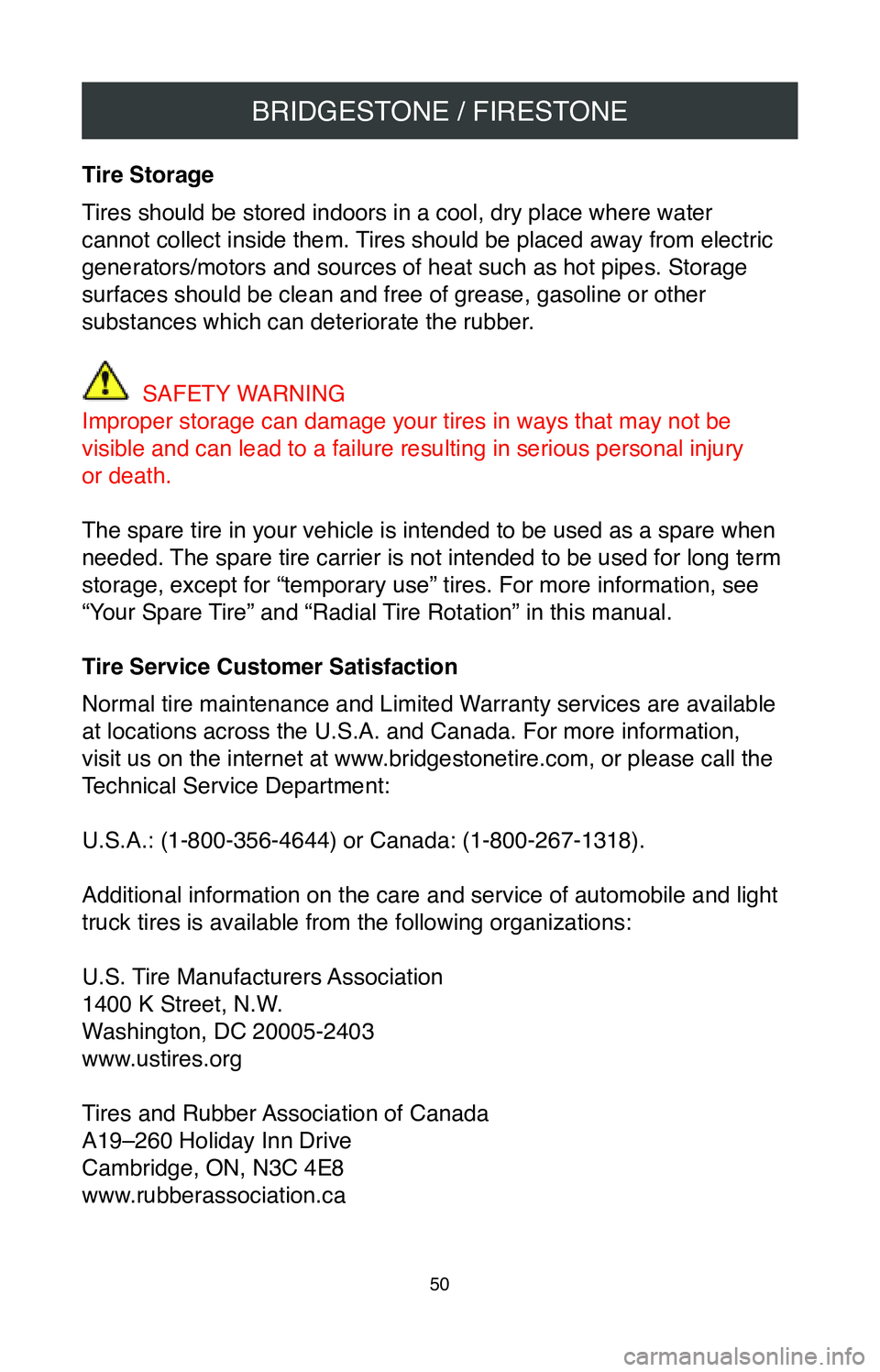
BRIDGESTONE / FIRESTONE
50
Tire Storage
Tires should be stored indoors in a cool, dry place where water
cannot collect inside them. Tires should be placed away from electric
generators/motors and sources of heat such as hot pipes. Storage
surfaces should be clean and free of grease, gasoline or other
substances which can deteriorate the rubber.
SAFETY WARNING
Improper storage can damage your tires in ways that may not be
visible and can lead to a failure resulting in serious personal injury
or death.
The spare tire in your vehicle is intended to be used as a spare when
needed. The spare tire carrier is not intended to be used for long term
storage, except for “temporary use” tires. For more information, s\
ee
“Your Spare Tire” and “Radial Tire Rotation” in this manual.
Tire Service Customer Satisfaction
Normal tire maintenance and Limited Warranty services are available
at locations across the U.S.A. and Canada. For more information,
visit us on the internet at www.bridgestonetire.com, or please call the
Technical Service Department:
U.S.A.: (1-800-356-4644) or Canada: (1-800-267-1318).
Additional information on the care and service of automobile and light
truck tires is available from the following organizations:
U.S. Tire Manufacturers Association
1400 K Street, N.W.
Washington, DC 20005-2403
www.ustires.org
Tires and Rubber Association of Canada
A19–260 Holiday Inn Drive
Cambridge, ON, N3C 4E8
www.rubberassociation.ca